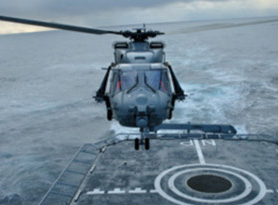Aerospace testing, whether military or commercial, is designed to validate the design and structural integrity of aircraft and it requires the highest accuracy and repeatability of test loads. When you consider the high value of the prototypes and the time sensitivity of new projects conducted by aircraft manufacturers, protecting the test specimen is absolutely paramount. Thus aerospace testing requires Moog to develop some of the most advanced testing and simulation solutions that push the absolute limits of technology allowing manufacturers to conduct rigorous and stringent test programs to ensure they meet a wide range of mission-specific performance, regulatory and commercial requirements.
This article discusses two recent projects where Moog worked closely with customers to create complex yet flexible test systems using state of the art hardware and software. The helicopter testing system that Moog developed with the Korean Aerospace Research Institute (KARI) runs full-scale structural tests and has potential for 12 independent helicopter tests. The helicopter rotor blade fatigue testing system developed for AgustaWestland pushes the limits of technology to provide complex data on loads during different maneuvers for ground and in-flight conditions. Both involved specialized testing servocontrollers with Real-Time Ethernet platforms capable of the accuracy and repeatability of up to 500 control channels yet with complete management of specific safety procedures.
What is Unique about Motion Control in Aerospace Testing?
In static and fatigue testing, commercial and military aircraft manufacturers place great emphasis on the accuracy of performance, repeatability of the test loads applied to their structures, and safety of the test specimen. The high value of the aero-structures and components requires advanced experience in a wide range of engineering disciplines and specialty areas.
Moog is the designer, manufacturer, and integrator of test and simulation systems and products for some of the most well-known aircraft manufacturers and test laboratories around the globe. Some of the trends that Moog is spearheading to meet the needs of this industry are incorporating advances in Real-Time Ethernet interfacing, data acquisition and control into advanced test systems as well as ways to provide faster testing. This allows aircraft manufacturers to undertake a growing range of test tasks more easily, reduce set-up time and optimize test running rates. Of course, accuracy and test specimen safety need to always be maintained even as these improvements in speed are made.
Faster testing is key to the success of aerospace manufacturers and this is where real operational improvements can be made in the lab. Test systems must be operational for long periods of time, anywhere from 2 to 6 years, to be able to run comprehensive and conclusive tests to verify aerodynamics and fatigue factors under a variety of conditions and loads. Moog has recently introduced a combination of communication interfaces based on Real-Time Ethernet that increases the functionality of servocontrollers and boosts bandwidth. Speed is improved by providing faster graphics, accurate synchronization of up to 500 control channels, reduced latency time and complete management of specific safety procedures to eliminate any risk on the test specimen. It also enables fast, easy to set up test systems that can be integrated with the users’ existing test and laboratory infrastructure.
Another type of testing, known as Iron Bird solutions can be used to study and test flight controls, landing gears, and hydraulics of an aircraft system. Both the correct functioning of different aircraft systems, as well as endurance testing can be supported. Moog offers a hydraulically powered computer-controlled loading system to reproduce in-flight aerodynamic loads. During the test, the user can define virtually any real time relationship between any input and output including modifying mathematical functions, using measured values, and applying values of any channel or pseudo channels (e.g. real time updated calculations) as parameters. This allows for programming of different load versus angle curves for each flight phase to be automatically sequenced during the iron bird test. This requires a fully integrated multiple channel system with higher communications bandwidth that allows large scale multi-channel tests to be run faster with improved safety.
Helicopter Testing System for the Korean Aerospace Research Institute
Moog was awarded a project to help KARI develop leading-edge test capabilities for a wide range of structural and fatigue tests for helicopters’ components. This system is part of a multi-billion dollar procurement project by the South Korean Ministry of National Defense that involves developing and building 245 utility helicopters over a 16-year period.
Moog’s previous experience with similar test rig installations, knowledge of helicopter test techniques and on-the-ground technical support from its Korean engineering team were key reasons for KARI’s selection of Moog for this project. That system, which was installed in just three days in 2008, now runs full-scale structural tests and has potential for 12 independent helicopter tests.
Key deliverables of this highly customized test rig installation include:
- Six cabinets with 16 control channels each
- A 256-channel HBM Catman Data Acquisition System
- New software functionality that allows Real-Time Ethernet-based data transfer between the command generator (Real-Time Front End) and the localized control loops
- A dedicated Ethernet interface for the transfer of the load cell, position and spectrum data from the Moog Test Controller to the CatMan data acquisition unit and activation of commands (e.g. Take Snapshot) from the Test Controller System to the CatMan System
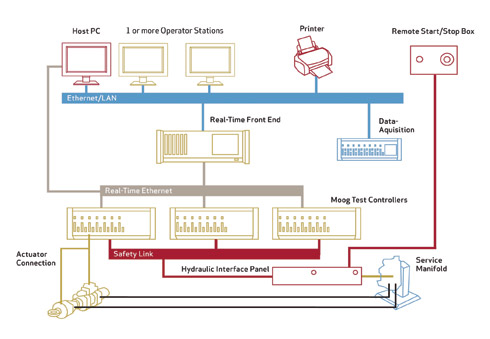
The system also delivers faster, more efficient analysis and comparison of tests. Because the two systems are connected via Ethernet, KARI can directly cross-check data from the Load Control System and Data Acquisition System through time stamps. This allows all data to be stored and archived on a hard disk for post-test analyses. Currently, KARI’s test program runs eight distinct and independent component tests simultaneously. Moog’s test rig also needed to allow for future upgrading in line with KARI’s plans to develop new facilities to run more ambitious test plans as the helicopter build program expands.
Moog’s test controllers incorporate a unique control loop technology that can handle complex multi-channel tests of up to 500 servo channels. Their flexibility -and high performance handling of complex testing formulas utilizing proprietary software are particularly suited for advanced aerospace testing. Moog provides servocontrollers that run structural tests (static and dynamic) ranging from complete aircraft and sub-assemblies to components.
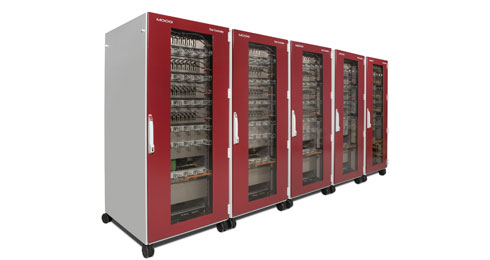
Bank of Moog Aerospace Test Controllers
Helicopter Rotor Blade Fatigue Testing System for AgustaWestland
An important part of helicopter development is the fatigue testing of the rotor blades. During operation helicopter rotor blades are subject to substantial flap (vertical), lag (horizontal), torsion and centrifugal (CF) loads. Flap and lag occurs as bending of the blade as well as shear loading. The Moog Aerospace Test System, in conjunction with the HBM Data Acquisition System, has been designed to accommodate all of these elements and to ensure the required relationship between the flap, lag and torsion moments on the blade at all times.
At AgustaWestland all test conditions are defined in terms of CF load, flap, lag and torsion moments to be applied at a particular blade station (span-wise location). Moments and torsions are measured by strain gauges installed along the blade. As it is possible for strain gauges to be damaged during fatigue testing these must not be used to close the control loop. The controller must therefore control the loading actuators in force mode using 6 load cells to provide the individual loop feedback.
To meet the specifications Moog supplied the Aerospace Test Controller, with 6 servo control channels, incorporating the latest Quad Core IPC processor and real-time Ethernet platform to allow playback of the complex loading spectrum on the helicopter blade. Fatigue loads vary during different manoeuvres, both for ground and in-flight conditions. Moog’s Aerospace Test Software accommodates this by the use of multi-level instruction blocks. A fatigue spectrum for rotor blades consists of up to 200 instruction blocks containing a total of 10 million fatigue cycles.
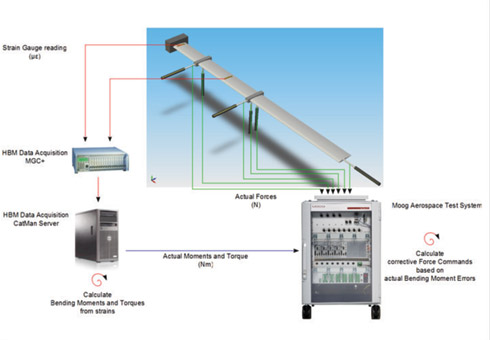
Moog’s Aerospace Test System proved to be a perfect match for AgustaWestland’s fatigue test application, offering all functionality needed by the test engineers in one, all-embracing, software suite.
Conclusion
These recent test system installations by Moog involved a fully integrated multiple channel system that combines Moog software and test controllers and including real-time Ethernet interfaces. The test systems feature a higher communications bandwidth that allows large scale multi-channel tests to be run faster with improved safety. By using advanced technology, world-class products and application know-how, Moog was able to deliver the complex requirements of faster testing, while ensuring the highest accuracy, repeatability and safety. Expertise gained by working in industries such as aerospace testing enables Moog to implement advanced solutions in other industries with similar complex requirements for multi-channel control and faster throughput.
Appendix A: Detailed Description of Helicopter Blade Fatigue Testing Control System
To apply the correct bending moments on the rotor blade cascaded closed-loop control is used, where an inner loop is controlling 6 servo-hydraulic loading actuators in force mode and an outer loop is adjusting the actuators’ command set points based on current bending moment errors.
The strain gauges are measured and converted into bending moments by the HBM Data Acquisition System and then sent to the Moog controller via a bi-directional Ethernet communication interface. In the Aerospace Test Software these ‘actual’ bending moments are compared against ‘desired’ bending moments using a corrective PID loop in soft real-time. The output of the PID loop is translated into force commands, for the individual force loops, using a 6×6 Transfer Matrix. The Transfer Matrix is setup using the Aerospace Test Software’s online calculation channels, called Shared Memory.
It is assumed that the transfer functions for the lag movements and the flap and torque movements are decoupled, then blade bending moments and blade forces are related as:
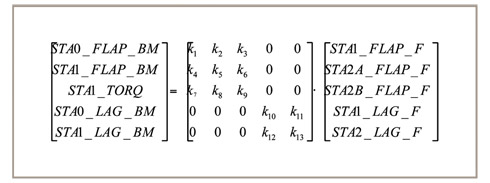
(vertical), lag (horizontal), torsion and centrifugal (CF) loads. Flap and lag occurs as bending of the blade as well as shear loading. The Moog Aerospace Test System, in conjunction with the HBM Data Acquisition System, has been designed to accommodate all of these elements and to ensure the required relationship between the flap, lag and torsion moments on the blade at all times.
At AgustaWestland all test conditions are defined in terms of CF load, flap, lag and torsion moments to be applied at a particular blade station (span-wise location). Moments and torsions are measured by strain gauges installed along the blade. As it is possible for strain gauges to be damaged during fatigue testing these must not be used to close the control loop. The controller must therefore control the loading actuators in force mode using 6 load cells to provide the individual loop feedback.
To meet the specifications Moog supplied the Aerospace Test Controller, with 6 servo control channels, incorporating the latest Quad Core IPC processor and real-time Ethernet platform to allow playback of the complex loading spectrum on the helicopter blade.
Fatigue loads vary during different maneuvers, both for ground and in-flight conditions. Moog’s Aerospace Test Software accommodates this by the use of multi-level instruction blocks. A fatigue spectrum for rotor blades consists of up to 200 instruction blocks containing a total of 10 million fatigue cycles.
However, while running the test, the commanded forces are a matrix multiplication of the bending moments. As a result the relation becomes:

So, the constants c1…c9 are an inverse of constants k1…k9:
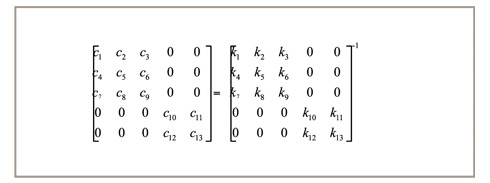
The matrix constants c1…c9 are determined during a system identification process. During this process the individual actuators are controlled to several representative forces. For each load applied, the measured bending moment is registered. The constants of the Transfer Matrix are loaded into the controller during the test start-up procedure using the controller scripting functionality.
The corrections to the inner force loop commands are made at intervals, rather than instantaneously. This is because it is necessary to verify that the bending moment information can be relied upon to guard against damage of the strain gauges before the system responds to the outer loop. The control system brings the test to a controlled stop in the event of significant errors being detected, or an emergency stop switch being operated.
Authors and Contributors
Stuart Bibb, T Eng. Mechanical Engineering, Managing Director Test Systems, Moog in the UK has 20 years experience in the automotive industry in vehicle development and test laboratory management as well as 20 years as a company director responsible for general business administration, sales and applications engineering.
Marie-Laure Gelin, MBA degree, Marketing Manager for Moog, brings over 15 years of experience in Marketing including business integration, brand strategy, corporate communications, market research and public relations for multinational companies from different industries.
Karel van Gelder, M.Eng.Sc (control electronics) is Product Line Manager for Moog’s Industrial Test Controllers. He brings 18 years of experience in engineering, project management and management of product development in the Aerospace and Automotive markets.
Hans Klaufus, MSc (Aerospace Dynamics), BSc (Aerospace Technology), Program Manager for Business Unit Test Systems. He brings 10 years of experience in project and program management for Moog Test Systems.
Thomas Pierce, BAEM (Aerospace Engineering) & MS (Aerospace Engineering) is the Business Development Manager for Pacific Test & Simulation Markets. He brings 28 years of experience in engineering, project management, product management, sales and market management, and general management during a career with several multinational companies. Tom has over 21 years of Asian experience and has lived in Asia for more than 12 years.
Stephan Ploegman, BSc. (Aerospace Technology), Project Manager for Aerospace Test Systems, brings 8 years of experience in project management and applications. His previous experience has been with project management for an international company specializing in aerospace equipment.
Paul Garner, B.A . (Computing & Electronics), HNC (Mechanical Engineering), is a Senior Sales & Application Engineer for Moog Test Systems in the UK. He brings over 30 years experience in test systems use, sales and support gained in various sectors in the Automotive and Aerospace Test industry.

